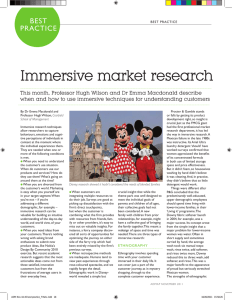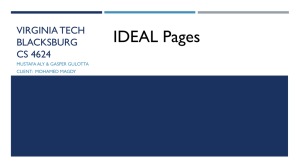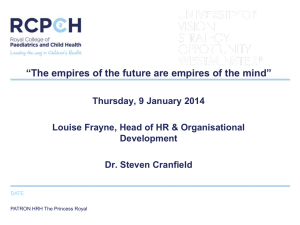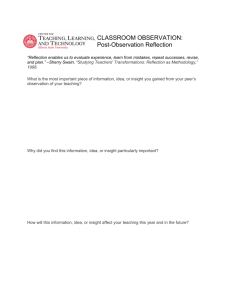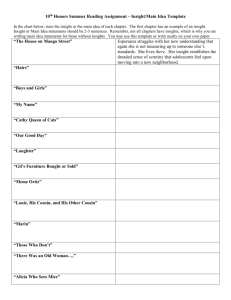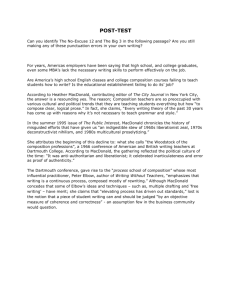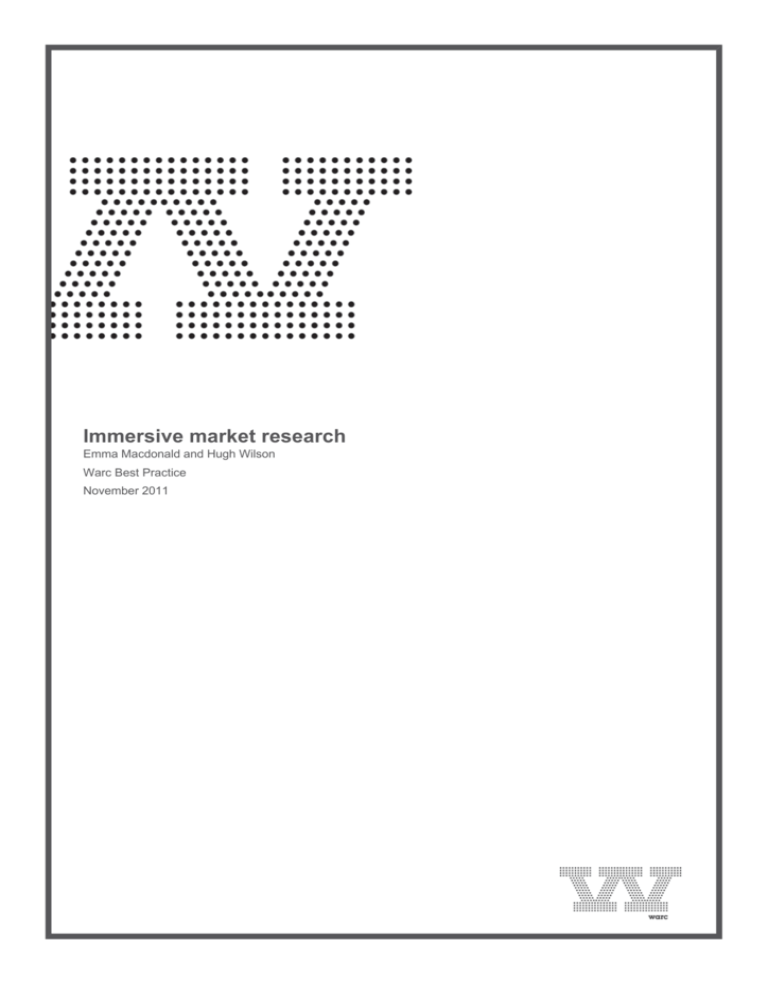
Immersive market research
Emma Macdonald and Hugh Wilson
Warc Best Practice
November 2011
Title:
Author(s):
Source:
Issue:
Immersive market research
Emma Macdonald and Hugh Wilson
Warc Best Practice
November 2011
Immersive market research
Emma Macdonald and Hugh Wilson
Cranfield School of Management
Professor Hugh Wilson and Dr Emma Macdonald describe when and how to use immersive techniques for
understanding customers.
Disney, research showed it hadn't considered the needs of blended families
Immersive research techniques allow researchers to capture behaviours, emotions and cognitive perceptions of individuals in
context at the moment where the individual experiences them. They are needed when one or more of the following conditions
is met.
l
When you need to understand the customer's use situation. When do customers use our products and services? How do
they use them? What's going on around them at the time?
l
When you are divorced from the customer's world. Marketing is easy when you yourself are in your target segment. When
Downloaded from warc.com
2 you're not - if you're addressing a different demographic, for example -immersive research can be valuable for building an
intuitive understanding of the day-to-day world, and world view, of your customers.
l
When you need ideas from your customers. There's nothing wrong with asking brand enthusiasts to submit new product
ideas, like Nokia's Design By Community 2010 exercise. But recent academic research suggests that the most actionable
ideas come not from these satisfied, innovative customers but from the frustrations of average users in their everyday
lives.
l
When customers are integrating multiple resources to do their job. Surveys are good at picking up dissatisfaction with the
firm's direct touchpoints, but when the customer is combining what the firm provides with resources from friends, family or
other providers, it's easy to miss out on valuable insights. For instance, a ferry company discovered all sorts of
opportunities for optimising the journey on either side of the ferry trip which had been entirely missed by the firm's
previous surveys.
l
When retrospective methods are inadequate. Humans tend to view past experiences through rose-coloured spectacles,
and we rapidly forget the detail. Ethnographic work in Disney- world revealed a simple but crucial insight: that while the
theme park was well designed to meet the individual goals of parents and children of all ages, their collective goals had
not been considered. A new family with children from prior relationships, for example, might have a collective goal of
bringing the family together. This meant a redesign of space and time was needed. There are three types of immersive
research:
ETHNOGRAPHY
Ethnography involves spending time with your customer immersed in their daily life. It can cover just a part of the customer
journey, as in mystery shopping, through to the complete customer experience.
Procter & Gamble stands or falls by getting its product development right, so insight is crucial. Just as the FMCG giant had the
first professional market research department, it has led the way in immersive research. A Mexican failure in the late 1980s
was instructive. Its Ariel Ultra laundry detergent ‘should’ have worked: surveys confirmed that women appreciated the benefits
of its concentrated formula in both use of limited storage space and price effectiveness. But it didn't foam, so housewives
washing by hand didn't believe it was cleaning. And, in practice, they didn't believe that so little detergent would work.
Things were different after P&G concluded that the predominantly well-educated, upper demographic employees should
spend time living with lower-income families, in their ‘Living it’ programme. The Downy fabric softener launch in 2004, for
example, was a major success. Its concept arose from the simple insight that a major problem for lower-income women was
water. Often in short supply and sometimes carried by hand, the average wash took six manual steps: wash, rinse twice, add
softener, and rinse twice more. Downy reduced this to three: wash, add softener, and rinse. This was a major benefit to the
appearance of proud but seriously stretched Mexican women. The strengths of ethnographic approaches include the 360degree view of the customer experience, the picking up of unmet needs, and the observation of unintended uses of products
and services which may equally lead to new product ideas. Weaknesses include the sometimes prohibitive cost, the danger of
reaching conclusions from a small number of cases which may not be representative, and the impact on the customer's
behaviour of invading their space.
NETNOGRAPHY
Downloaded from warc.com
3 Netnography is online ethnography: immersion in the customers’ world through online spaces. It involves largely textual
analysis of content in consumer forums and/or blogs. Research may take the form of participant observation where consumers
know they are being observed, or it may involve ‘lurking’ in forums or analysis of archival material. Appropriate sites for
netnography range from brand-owned communities such as P&G's SuperSawyMe.com to third-party websites such as
consumer-driven sites like MacRumors.com.
Dr Neil Hair of Rochester Institute of Technology conducted participant observation netnography for a Premiership football
club over several months on its discussion board. After a while, fans opened up:
“I'm housebound with a long-term illness. This board truly is my lifeline. There's often days I'm too ill to type, but just reading
the posts in bed makes me feel less abnormal and alone. I'm so desperate to go to the ground it hurts, but speaking to people
on here who go is the next best thing.”
What supporters got out of it was far too implicit to emerge readily in a focus group, but overtime, the researcher could unpack
it: release, fun, friendship, a sense of belonging, self-esteem and escape. Armed with this insight, the club could optimise
these dimensions of value both online and offline. lt introduced a meeting point at the ground, for example, to connect fans
who had met online.
The strengths of netnography include the readily available, rich data, with no interview transcription costs. Also, customer-tocustomer interactions can be observed far more readily online than in most offline settings. Weaknesses include the bias from
sampling only the subset of the target market who participate actively online, and the social desirability bias of participants
reporting what they might imagine others want to hear.
PARTICIPANT REPORTING
An alternative to both of these is to ask the customer to do the research on the firm's behalf. Traditionally carried out by asking
the customer to fill in a paper diary, variations include research agency Mesh Planning’s innovative TROI (Touchpoint Return
On Investment) method, in which a panel of consumers sends a structured text message whenever they encounter the brand.
Whatever the technology, the aim is to capture the customer’s experience as it occurs, without the need for a researcher to be
with them. Why was a campaign for Lynx (known in some countries as Axe) working perfectly in countries such as Poland but
not in Italy? Unilever found out fast using the TROI method. By capturing every brand contact from marcoms and word-ofmouth to usage as it occurred, they were able to spot the difference.
While young Italians loved the TV ads just as much as the Poles, in Poland this was followed up by effective local activation,
from shop window posters and in-store displays to sampling on the street. This bridged the gap between the TV ad at home
and a purchase opportunity. Conventional media evaluation would have missed this insight.
The strengths of participant reporting include its holistic coverage of the complete customer journey, and the mix of qualitative
and quantitative insight it can provide, allowing statistical analysis of which experiences are most influential. Weaknesses
include the difficulty in estimating the mere measurement effect on the respondent of the act of participating in the study – a
control group can help here – and the need to motivate study participants.
SUMMARY
Surveys and focus groups are invaluable, but there are many parts of the customer journey which they find difficult to reach,
Downloaded from warc.com
4 and they are stronger at assessing customer reactions to the firm’s current products and services than they are at
understanding the context within which these products are applied. Immersive techniques have become a vital part of the
insight toolbox.
As these methods are holistic, the insights will be wide-reaching in their implications, so actioning this insight requires the
involvement of a wide range of stakeholders – operations and service as well as marketing.
But even better can be to involve senior managers directly in the research, as happens at Proctor & Gamble, and at
Sainsbury’s where the supermarket giant keeps its customer experience up by asking board directors to spend time every
month working in the store and accompanying customers shopping. Such direct immersion is worth any number of market
research reports.
FURTHER READING ON WARC.COM
P&G Adapts in Emerging Markets, WARC News, 201 1
Digital Anthropology, Ray Pettit. Journal of Advertising Research, 2010
The Ethical Dilemmas and Challenges of Ethnographic Research in Online Communities, Neil Hair and Moira Clark
International Journal of Market Research, 2007
Capturing How a Catchphrase Caught On, Ana Medeiros and Fiona Blades. MRS Annual Conference 2008
OTHER RECOMMENDED READING
The Game-Changer, A F Lafley and R Charan, Crown Business, 2008
ABOUT THE AUTHOR
Dr Emma K. Macdonald is Senior Research Fellow in Marketing at Cranfield School of Management.
emma.macdonald@cranfield.ac.uk
Prof Hugh Wilson is Professor of Strategic Marketing at Cranfield School of Management.
hugh.wilson@cranfield.ac.uk
© Copyright Warc 2011
Warc Ltd.
85 Newman Street, London, United Kingdom, W1T 3EX
Tel: +44 (0)20 7467 8100, Fax: +(0)20 7467 8101
www.warc.com
All rights reserved including database rights. This electronic file is for the personal use of authorised users based at the subscribing company's office location. It may not be reproduced, posted on intranets, extranets
or the internet, e-mailed, archived or shared electronically either within the purchaser’s organisation or externally without express written permission from Warc.
Downloaded from warc.com
5

